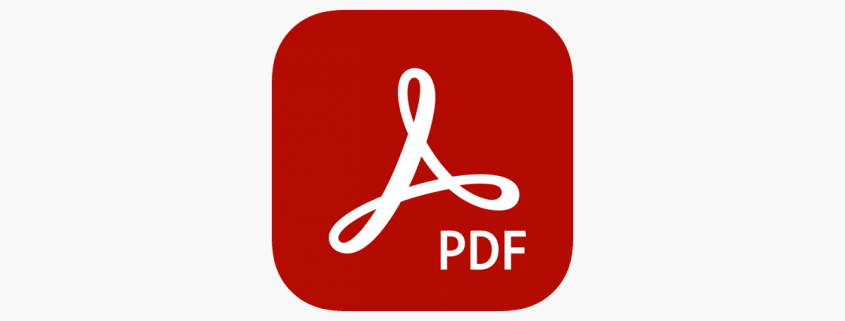The PDF Is Timeless – Birth of PDF
PDFs we use them all the time. You most likely have used one today or at least this week. One estimate is there are 2.5 trillion PDFs in existence. So where did the PDF come from?
Have you ever thought about where the PDF came from? A PDF is a Portable Document Format file, it essentially strives to replace paper in digital form. It’s been around since pre-web 1990s. Think about it Microsoft Word has competitors in Google (Google Docs) and Apple (Pages). PDF, no killer app has emerged. Adobe reported that in 2020’s fiscal year alone 303 billion PDFs were opened using is Document Cloud Service. Which was a 17% annual increase in a year that had tech conversations dominated by video conferencing. A PDF is the digital equivalent to a paper clip or ballpoint pen. An every day tool if you will, it’s so familiar it seems to have come out of nowhere, with it being hard to imagine it not being around.
John Warnock, who co-founded Adobe in 1982 with Charles Geschke is closely identified as PDF’s inventor. Around a tech that was called PostScript, a language for making computer documents easily printable.
PDF’s Goal
The official term of the PDF and it’s goal from adobe is to be able to
“exchange information between machines, between systems, between users in a way that ensured that the file would look the same everywhere it went.”
Which meant creating “a digital interchange format that preserved author intent,” says David Parmenter, director of engineering for Adobe Document Cloud, “which is, at a really high level, what a PDF tries to do.” Therefore the mission of the PDF is simply the digital version of paper.
The PDF essentially achieved this goal, it looks the same on any device and it is small enough to share even three decades ago. Warnock wanted to replace paper. Putting PDF at the center of the dream of a paperless office. The 1990s brought with it loads of competitors DjVu, WordPerfect’s Envoy, Common Ground Digital Paper all wanting to replace paper.
PDFs Birth
Adobe announced the PDF in 1992 and in 1993 released software for creating and reading the format. According to One History, Adobe’s PDF making programme in 1993 cost approximately $700 and the reader cost $50! It was not an immediate success. Warnock later said that the “world didn’t get it”, Adobe even wanted to kill Acrobat outright. While, not just the cost was an issue, PDFs were cumbersome than plain text and were slow to download at the time.
The IRS
While it was the mainstreaming of the web and improving download speeds helped the PDF. It weren’t until the the Internal Revenue Service, the IRS, embraced the PDF it took off. Mailing tax forms was complicated and expensive. Making them available in PDF form was a breakthrough. Easy to download and a reliable format. It weren’t long until other industries also took on the PDF. IRS using the PDF served as a a case study which proved PDF’s value to business, academia, law firms, medicine, and others.
Adobe wanted to make PDF better than paper and has continuously made it better. For example adding hyperlinks, signature boxes and answer fields to PDF’s
PDFs Turning A Corner
In 2008, Adobe took a decisive step in PDF’s life cycle. Adobe allowed the format’s specs to be published and ultimately controlled by the independent nongovernmental organization International Organization for Standardization, granting royalty-free rights to use of the relevant patents to make or sell uses of the PDF spec.
Which is one reason as to why there are loads of PDF creation tools and readers beyond Adobe’s. You can now create PDF’s easily. Such as save a Word document as a PDF. You can open the PDF in any reader you wish as well. The PDF is not the only electronic document format on the web it is very dominant.
Many assume that Adobe still owns the format, they hold a seat on the ISO committee but they hold no more power than anyone else on the committee. Nor do they have anymore power to shaping the format’s standards.
Adobe’s close association with the PDF has been key to the success of Adobe’s document software, Acrobat. Adobe runs a cloud/subscription model for it’s other products and the ability to create and edit PDF’s is at the center of it’s “Document Cloud” offering. While they had a total of $1.5B in fiscal 2020.
Future of the PDF
PDF from the start was meant to be lightweight and forward compatible. Meaning that whatever was created in the future, PDF’s would still be able to be readable. According to Adobe even the first PDFs remain legible to latest reader tools. Much like paper, if you pick up a 100 year old book, you don’t need to download any updates to read it. The same applies to the PDF.
While David Parmenter says about technology on a whole that “You only think about it when it doesn’t work. And happily, for PDFs, that’s quite rare.”
[Medium]
Questions for you….
- Do you use PDF’s a lot?
- What do you like about PDFs
- Can you live without a PDFs
- How do you think PDF’s will evolve?
- Will the PDF eliminate paper eventually
- What will eliminate paper
- How would you eliminate paper?
- How would life today look like if PDF never existed
So, keep up to date with everything How To Kill An Hour by signing up to our newsletter by clicking here!
Also, let us know what you think of the show by clicking here!
While you are there click here to subscribe to our YouTube Channel to see more amazing ways to kill time!
Furthermore, follow us on Twitch by clicking here!



